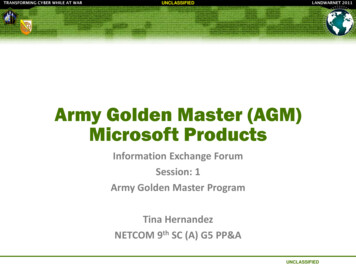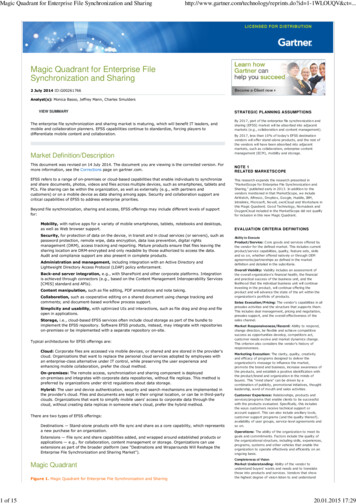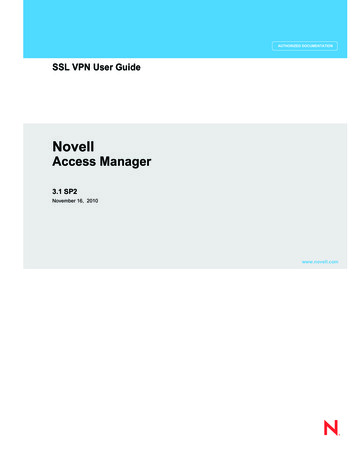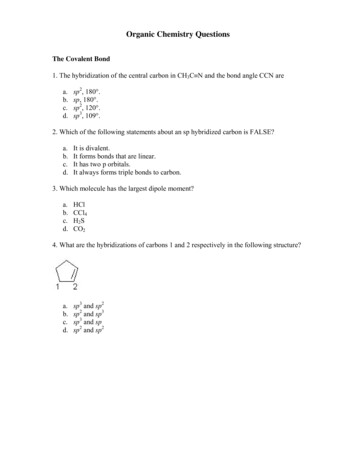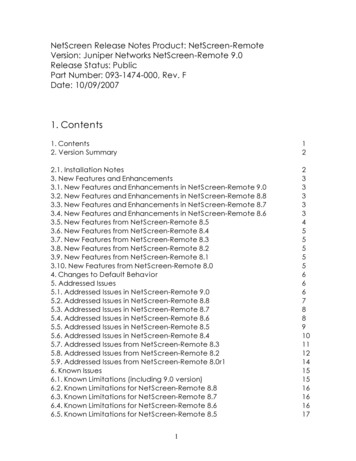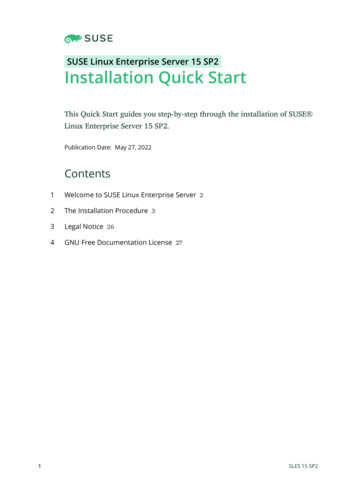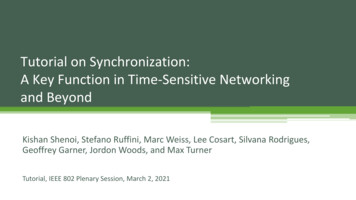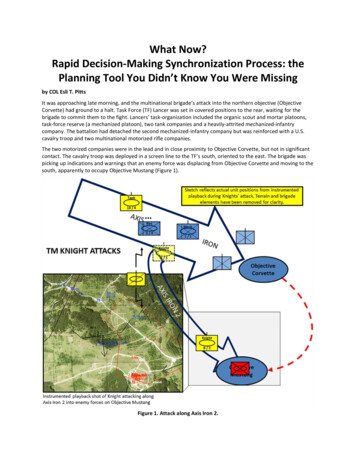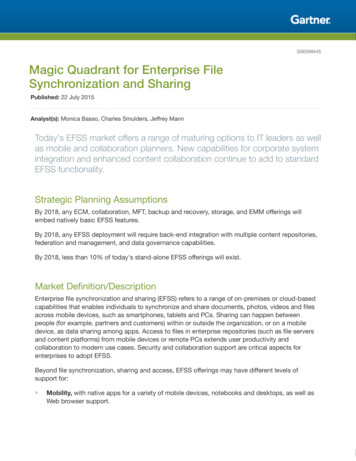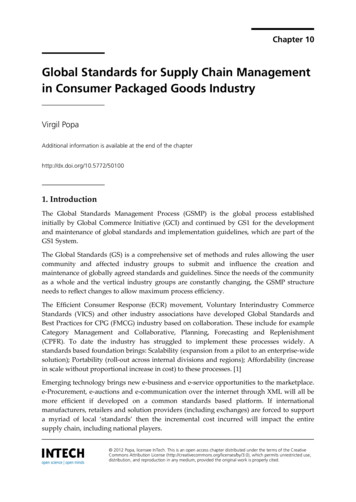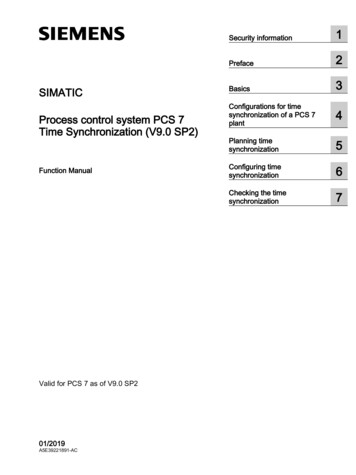
Transcription
SIMATICProcess control system PCS 7Time Synchronization (V9.0 SP2)Function ManualValid for PCS 7 as of V9.0 SP201/2019A5E39221891-ACSecurity information1Preface2Basics3Configurations for timesynchronization of a PCS 7plant4Planning timesynchronization5Configuring timesynchronization6Checking the timesynchronization7
Legal informationWarning notice systemThis manual contains notices you have to observe in order to ensure your personal safety, as well as to preventdamage to property. The notices referring to your personal safety are highlighted in the manual by a safety alertsymbol, notices referring only to property damage have no safety alert symbol. These notices shown below aregraded according to the degree of danger.DANGERindicates that death or severe personal injury will result if proper precautions are not taken.WARNINGindicates that death or severe personal injury may result if proper precautions are not taken.CAUTIONindicates that minor personal injury can result if proper precautions are not taken.NOTICEindicates that property damage can result if proper precautions are not taken.If more than one degree of danger is present, the warning notice representing the highest degree of danger will beused. A notice warning of injury to persons with a safety alert symbol may also include a warning relating to propertydamage.Qualified PersonnelThe product/system described in this documentation may be operated only by personnel qualified for the specifictask in accordance with the relevant documentation, in particular its warning notices and safety instructions. Qualifiedpersonnel are those who, based on their training and experience, are capable of identifying risks and avoidingpotential hazards when working with these products/systems.Proper use of Siemens productsNote the following:WARNINGSiemens products may only be used for the applications described in the catalog and in the relevant technicaldocumentation. If products and components from other manufacturers are used, these must be recommended orapproved by Siemens. Proper transport, storage, installation, assembly, commissioning, operation andmaintenance are required to ensure that the products operate safely and without any problems. The permissibleambient conditions must be complied with. The information in the relevant documentation must be observed.TrademarksAll names identified by are registered trademarks of Siemens AG. The remaining trademarks in this publicationmay be trademarks whose use by third parties for their own purposes could violate the rights of the owner.Disclaimer of LiabilityWe have reviewed the contents of this publication to ensure consistency with the hardware and software described.Since variance cannot be precluded entirely, we cannot guarantee full consistency. However, the information in thispublication is reviewed regularly and any necessary corrections are included in subsequent editions.Siemens AGDivision Process Industries and DrivesPostfach 48 4890026 NÜRNBERGGERMANYA5E39221891-AC 04/2019 Subject to changeCopyright Siemens AG 2019.All rights reserved
Table of contents1Security information.72Preface .93Basics .134563.1Using time synchronization in PCS 7 .133.2Time synchronization options for PCS 7 components .153.3Time displayed in PCS 7.163.4Time synchronization in distributed PCS 7 plants.173.5Central plant clock.203.6Time levels of a PCS 7 plant (stratum) .213.73.7.13.7.23.7.33.7.4Operating principle of time synchronization in PCS 7 .24Time sources for a PCS 7 plant .24Time master, time slave, and cooperative time master.25Legend for figures used in this documentation .26Example of the time synchronization sequence.273.83.8.13.8.23.8.33.8.43.8.5Network environment of a PCS 7 plant .30Overview .30Network environment within a domain .30Network environment within a work group .31Network environment in redundant, high availability networks .32Network environment on separate networks with one central plant clock.34Configurations for time synchronization of a PCS 7 plant .374.1Overview of recommended configurations.374.2Rules for time synchronization in PCS 7.384.34.3.14.3.2Configurations for time synchronization in a work group .39Configuration in a work group with central time master .39Configuration in a work group without central time master .414.44.4.14.4.24.4.3Configuration for time synchronization in a Windows domain.43Configuration in a Windows domain with a hierarchy with central time master .43Configuration in a Windows domain with a hierarchy without central time master .45Configuration in a Windows domain with multiple hierarchies .47Planning time synchronization.495.1Selecting the time master.495.2Selecting the central plant clock.505.3Time synchronization and high-precision time stamping for PROFINET IO fieldbus.52Configuring time synchronization .556.1Introduction .55Time Synchronization (V9.0 SP2)Function Manual, 01/2019, A5E39221891-AC3
Table of verview of configuration steps, depending on the configuration.57Time synchronization in a work group.57Time synchronization in a work group with central time master.57Time synchronization in a work group without central time master.59Time synchronization in a Windows domain .60Time synchronization in a Windows domain with a hierarchy with central time master.60Time synchronization in a Windows domain with a hierarchy without central time master.626.36.3.16.3.26.3.36.3.4Commissioning a central plant clock.64Commissioning the SICLOCK timers .64Commissioning the Buerk timers .67Commissioning GPS receivers for SICLOCK timers.72Commissioning the DCF 77 receiver for SICLOCK 4.3.26.4.46.4.4.16.4.5Configuring the time synchronization for PC stations with OS.76How to assign parameters for a CP 16x3 / CP 16x8 communications processor.76Setting the time displayed .77How to configure the operator station display .77How to convert the local time zone and daylight saving time parameters .79Parameter assignment for an OS server in a work group .81How to assign parameters for an OS server in a work group with central time master .81How to assign parameters for an OS server in a work group without central time master.83Parameter assignment for an OS server in a Windows domain .85How to assign parameters for an OS server in a Windows domain with a hierarchy withcentral time master.85How to assign parameters for an OS server in a Windows domain with a hierarchywithout central time master .88How to assign parameters for an OS client .916.56.5.16.5.1.16.5.1.2Configuring time synchronization for a PC station without OS .92Overview of configuration steps .92How to synchronize PC stations without OS using the NTP mode .93How to make DCF 77 Client Service settings on a PC station without OS onfiguring time synchronization on an AS .100Time synchronization with central plant clock and S7-400 modules.100Configuration 1.101Explanations for configuration 1.101How to configure configuration 1.102Configuration 2.104Explanations for configuration 2.104How to configure configuration 2.1056.76.7.26.7.36.7.46.7.5Configuring the time synchronization for SIMATIC PCS 7 BOX RTX and SIMATIC PCS 7AS RTX .107Overview of time synchronization for SIMATIC PCS 7 BOX RTX and SIMATC PCS 7 ASRTX .107How to set the time synchronization source.108How to set the OS properties .109How to configure the time synchronization for the AS .110How to set OS time synchronization .1116.86.8.16.8.2Configuring time synchronization with multiple networks.113Configuring time synchronization for separate networks using a central clock.113How to configure SCALANCE X414-3E for separation of time frames .1146.4.4.26.7.14Time Synchronization (V9.0 SP2)Function Manual, 01/2019, A5E39221891-AC
Table of contents6.96.9.176.9.2Configuring redundant PCS 7 systems .116How to configure time synchronization of OS servers with a redundant communicationmodule and external clock .116How to configure time synchronization on a PCS 7 system with redundant bus system.1176.106.10.1Configuring the time synchronization of the domain controllers (DC) .118How to configure time synchronization of the domain controller.118Checking the time synchronization.1197.1How to check the time on the PC stations .1197.2How to check the time on an OS server with CP 16x3 / CP 16x8.1217.3How to configure the status check of the time master role of the OS server .122Glossary .123Index.127Time Synchronization (V9.0 SP2)Function Manual, 01/2019, A5E39221891-AC5
Table of contents6Time Synchronization (V9.0 SP2)Function Manual, 01/2019, A5E39221891-AC
Security information1Siemens provides products and solutions with industrial security functions that support thesecure operation of plants, systems, machines and networks.In order to protect plants, systems, machines and networks against cyber threats, it isnecessary to implement – and continuously maintain – a holistic, state-of-the-art industrialsecurity concept. Siemens’ products and solutions constitute one element of such a concept.Customers are responsible for preventing unauthorized access to their plants, systems,machines and networks. Such systems, machines and components should only be connectedto an enterprise network or the internet if and to the extent such a connection is necessary andonly when appropriate security measures (e.g. firewalls and/or network segmentation) are inplace.For additional information on industrial security measures that may be implemented, ity.Siemens’ products and solutions undergo continuous development to make them more secure.Siemens strongly recommends that product updates are applied as soon as they are availableand that the latest product versions are used. Use of product versions that are no longersupported, and failure to apply the latest updates may increase customer’s exposure to cyberthreats.To stay informed about product updates, subscribe to the Siemens Industrial Security RSSFeed me Synchronization (V9.0 SP2)Function Manual, 01/2019, A5E39221891-AC7
Security information8Time Synchronization (V9.0 SP2)Function Manual, 01/2019, A5E39221891-AC
2PrefacePurpose of this documentationThe time synchronization documentation provides support for the configuration andcommissioning of the "time synchronization" function in a PCS 7 plant.The documentation provides information about the following topics: Time synchronization in a PCS 7 plant Planning time synchronization in a PCS 7 plant Configuring time synchronization for a PCS 7 plantNoteYou can find information on high-precision time stamping in the function manual PCS 7Process Control System; High-precision time stamping.StructureThe documentation is organized according to the following topics: Fundamentals of time synchronization mode of operation in a PCS 7 plant Configuration possibilities of PCS 7 with time synchronization Planning a PCS 7 plant with time synchronization Configuring the time synchronization for different plant configurationsTime Synchronization (V9.0 SP2)Function Manual, 01/2019, A5E39221891-AC9
PrefaceTarget group and benefitThis documentation is intended for personnel working in the fields of sales, planning, andconfiguration:Target groupUsing the documentationTarget-group relevant chapters of the documentationSalesSales personnel give clear advice to their cus‐ "Fundamentals"tomers on implementing the "time synchroni‐ "Configurations for time synchronization of a PCS 7zation" function in a PCS 7 plant.plant" "Planning time synchronization"PlanningThe system planner uses the information in "Fundamentals"the documentation for optimal set up and the "Configurations for time synchronization of a PCS 7components necessary in this regard for plan‐plant"ning a PCS 7 plant with the "time synchroni‐ "Planning time synchronization"zation function".ConfigurationThe configuration engineer is provided withexact instructions relative to the "time syn‐chronization" function; these instructionsshow the specific steps that are necessary toadjust the time synchronization at all relevantpoints.10 "Configuring time synchronization"Time Synchronization (V9.0 SP2)Function Manual, 01/2019, A5E39221891-AC
PrefaceOptions for accessing PCS 7 documentationThe documentation required for PCS 7 includes the following types: PCS 7 ReadmeThe readme file is available in two versions:– PCS 7 Readme (offline)This version is installed by PCS 7 Setup. The file only contains general information andlinks to documents on the Internet.– PCS 7 Readme (online)This version contains all information on the installation and use of PCS 7 in the formatwhich is already familiar to you. The file is only available on the Internet to keep it alwaysup-to-dateNoteThe information provided in the PCS 7 Readme (online) on the Internet takesprecedence over all other PCS 7 documentation.Read this PCS 7 Readme carefully, because it contains important information andamendments on PCS 7. PUD ManagerThe "PUD Manager" an innovative tool to access documentation, comes with PCS 7 DVD.Some of the highlights:– Create your own Manual Collection.– Customize the documentation set according to your needs.– Efficient search engine to access your information.To install the PUD manager and integrate the documents. refer to Siemens Industry /en/view/109748882) PCS 7 System DocumentationSystem documentation contains information that covers several products, such asconfiguration manuals and Getting Started manuals. This documentation serves as aguideline for the overall system and explains the interaction between the individualhardware and software components.Note the information on "PCS 7 Documentation Portal Setup" in the productoverview Process Control System PCS 7; PCS 7 ‑ Documentation; Section "Options foraccessing the documentation" PCS 7 Product DocumentationProduct documentation contains information about special hardware and softwarecomponents. The individual documents provide detailed information on the specificcomponent. PCS 7 Technical Information and SolutionsFor important technical information and solutions, refer to SIMATIC PCS 7 Overview w/63481413).Full versions of the documentation are available from the "Technical Documentation SIMATICPCS 7" website: www.siemens.com/pcs7-documentation (www.siemens.com/pcs7documentation)Time Synchronization (V9.0 SP2)Function Manual, 01/2019, A5E39221891-AC11
PrefaceSkills requiredOnly qualified personnel should commission and operate the PCS 7 products.Skills in the following areas are prerequisite: STEP 7 PCS 7 "Automation technology" Basic WinCC skills For plants with a domain structure: Knowledge of the Windows administrationConventionsIn this documentation, the names of elements in the software user interfaces are specified inthe language of this documentation. If you have installed a multi-language package for theoperating system, some of the designations will be be displayed in the basic operating systemlanguage even after you change the language and will, therefore, differ from the designationsused in the documentation.If you use the operating system Windows 10, you will find the Siemens SIMATIC programs inthe Start menu under the menu command All apps Siemens Automation.Buerk timer specific procedure or tasks are explained separately.For common features, the images shown in the manual for SICLOCK will remain same forBuerk timers.For Buerk specific operations,new images are added.Changes compared to the previous versionBelow, you can find an overview of the most important changes in the documentation comparedto the previous version.New as of PCS 7 V9.0 SP2 Implementation of Buerk timersNew as of PCS 7 V9.0 Time synchronisation for time stamping on PROFINET IO (Page 52)12Time Synchronization (V9.0 SP2)Function Manual, 01/2019, A5E39221891-AC
3Basics3.1Using time synchronization in PCS 7IntroductionPlants in which Process Control Systems are used contain numerous components thatexchange data. Most plants require time synchronization for controlling processes andinformation. There are additional requirements in terms of the documentation of eventsequences.If the timing of components in the overall system is not synchronized, these tasks can only besupported by the internal clock of the individual components.Components that are equipped with an internal hardware clock (RTC Real Time Clock)include: Domain servers Servers Clients PC stations Automation systems I/O Sensors26 FOLHQWV% 7& FOLHQWV UFKLYH VHUYHU5RXWH &RQWURO FOLHQWV% 7& VHUYHU6,0 7,& ,77HUPLQDO EXV26 VHUYHU(QJLQHHULQJ VWDWLRQ5RXWH &RQWURO VHUYHU3ODQW EXV XWRPDWLRQTime Synchronization (V9.0 SP2)Function Manual, 01/2019, A5E39221891-AC(7 0352),%86 '3352),%86 '3352),%86 '3V\VWHPV 63&6 %2; LJK DYDLODELOLW\DXWRPDWLRQ V\VWHPV)DLO VDIH DXWRPDWL RQ V\VWHPV(7 013
Basics3.1 Using time synchronization in PCS 7Time synchronizationTime synchronization means that one system component (time master) provides a precise timefor all the other components (time slaves). The time information (date and time) can either bedistributed by the time master, or be requested by the time slaves. This time information mustbe evaluated within the system by all components for the overall task.Time synchronization applicationsThe list below contains various examples of aspects requiring time synchronization of allcomponents within the process automation: Synchronizing processes Controlling complex sequences Logging and documenting sequences Validating processes Analyzing processes Analyzing the causes and effects of eventsPCS 7 functionsThe following list contains some of the key PCS 7 functions for which time synchronization isabsolutely necessary: Interpretation of causal relationships Message processing in correct sequence Time stamp Time-of-day interrupts Runtime meter Redundancy synchronization Batch monitoring Authentication of a domain client14Time Synchronization (V9.0 SP2)Function Manual, 01/2019, A5E39221891-AC
Basics3.2 Time synchronization options for PCS 7 components3.2Time synchronization options for PCS 7 componentsTime synchronization for PCS 7 componentsThe table below shows the PCS 7 components for which time synchronization is possible:StationTimesynchronizationFor more information, refer to the section .Operator station Via the terminalbus"Configuring the time synchronization for PC sta‐tions with OS (Page 76)" Via the plant busPC stations without OS Engineering stationVia the operatingsystem "How to make DCF 77 Client Service settings ona PC station without OS (Page 98)" "How to synchronize PC stations without OSusing the NTP mode (Page 93)" SIMATIC BATCHstation SIMATIC RouteControl station Process Historian Information Server SIMATIC ITASVia the plant bus"Configuring time synchronization on an AS(Page 100)"SIMATIC PCS 7 BOXRTXand SIMATIC PCS 7 ASRTXWhen integrated in aPCS 7 plant"Configuring the time synchronization for SIMATICPCS 7 BOX RTX and SIMATIC PCS 7 AS RTX(Page 107)"Domain controllerWith a domain con‐ "Configuring the time synchronization of the domaintroller as time master controllers (DC) (Page 118)"on the terminal busTime Synchronization (V9.0 SP2)Function Manual, 01/2019, A5E39221891-AC15
Basics3.3 Time displayed in PCS 73.3Time displayed in PCS 7Coordinated Universal Time (UTC)Coordinated Universal Time (UTC) is an international time basis based on the precision ofatomic clocks. UTC refers to the Greenwich prime meridian near London.UTC does not take daylight saving time into account.Local timeEast of the prime meridian, one or more hours is added to the universal time measured inGreenwich, depending on the distance in question. West of the prime meridian, the hours aresubtracted.The following table shows some examples of time zones and their time differences in relationto UTC:LocationTime zoneZone timeTimeGreenwich0. LongitudeUTC Coordinated Universal TimeUTC 12:00Berlin15. Eastern longitudeCET Central European TimeUTC 1h: 13:00Moscow45. Eastern longitudeMSK Moscow timeUTC 3h: 15:00Tokyo120. Eastern longitudeJST Japan/Korea Standard TimeUTC 9h: 21:00Buenos Aires45. Western longitudeNo designationUTC – 3h: 9:00Daylight saving time/standard timeA number of countries have introduced a change from standard time (local time) to daylightsaving time for the summer months.Example:In central Europe, standard time differs by plus one hour, while daylight saving time differs byplus two hours in relation to standardized universal time (UTC).UTCCET standard timeCEST daylight saving time12:00UTC 1h 13:00UTC 2h 14:00Time display in process modeIn PCS 7, the operator can toggle the time displayed on the operator station between UTC andlocal time while the plant is in process mode. The operator station can display the local time,including daylight saving time and standard time.NoteIf time-dependent data of different time zones is displayed or processed on a PCS 7component, then use UTC for display on the operator station as well.16Time Synchronization (V9.0 SP2)Function Manual, 01/2019, A5E39221891-AC
Basics3.4 Time synchronization in distributed PCS 7 plants3.4Time synchronization in distributed PCS 7 plantsIntroductionPCS 7 supports system configurations where subcomponents are installed at differentlocations, or even in different time zones. An example would be the installation of an automationsystem and an operator station at different locations. The time must be synchronized for theentire PCS 7 plant in order to optimize the sequence of all the processes.In PCS 7, the times of subcomponents are directly synchronized within a time zone. PCS 7 usesthe "time synchronization" function to synchronize different time zones.Time response in distributed PCS 7 plantsThe following figure shows that time jumps may occur in process control systems (for example,in the alarm lists) if there is no time synchronization. The processes do not run synchronously:2SHUDWRU VWDWLRQ%HUOLQ0HVVDJHV XWRPDWLRQ V\VWHP If the times for the components of a distributed PCS 7 plant are synchronized, all of theprocesses will run in correct chronological order and will be archived correctly.Time Synchronization (V9.0 SP2)Function Manual, 01/2019, A5E39221891-AC17
Basics3.4 Time synchronization in distributed PCS 7 plants2SHUDWRU VWDWLRQ%HUOLQ 0HVVDJHV7LPH V\QFKURQL]DWLRQ XWRPDWLRQ V\VWHP Rules for configuring distributed PCS 7 plantsSince PCS 7 plants generally operate on the basis of UTC internally, their specific componentscan be distributed on a global scale. In order to safeguard the interplay of components - evenacross different time zones - please observe the following: Use UTC as the common time base in all PCS 7 plants. All plant components running withUTC will display the same time after time synchronization. Set up a PC station as a PCS 7 Web server in all PCS 7 plants, using the PCS 7 OS weboption. This way you can access the PCS 7 Web server of the PCS 7 plants from companyheadquarters with several web clients (in PCS 7: WebNavigator Client or WebNavigatorDiagnostics Client). You can convert the time display on
Basics 3.8 Network environment of a PCS 7 plant. Time Synchronization (V9.0 SP2) 30. Function Manual, 01/2019, A5E39221891-AC. Network environment within a domain. 30. Network environment within a work group. 31. Network environment in redundant, high availability networks. 32. Network environment on separate networks with one central plant .
